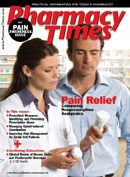Publication
Article
Pharmacy Times
From the Publisher: Reducing Pain, One Patient at a Time
Author(s):

Pharmacists deal with a host of ailments, but one of the most persistent conditions they see in their patients is chronic pain. September is Pain Awareness month, so we turn to this topic for our special issue this month. According to the American Medical Association, pain of all types is undertreated in our society. Physicians and patients alike—concerned about powerful side effects and the always-present fear of addiction—try to find that fine line between pain treatment and burgeoning chemical dependency. It is a continuing challenge, and an area where pharmacists can make a difference.
Just in the past several years, practitioners have recognized the growing need for more education in this area, and they have acknowledged the continued concern for the undertreatment of pain, especially in geriatric and pediatric populations. These and other concerns related to pain management were central themes at the recent PAINWeek conference in Las Vegas, Nevada. As the only national pain conference that disseminates knowledge and tools to clinicians—including physicians, nurses, physician assistants, dentists, psychologists, podiatrists, and of course, pharmacists— the topics presented there (and reported by our sister publication, MDNG: Pain Management) are at the forefront of clinical research, treatment options, and best practices to combat these conditions.
Chronic and acute pain touch the lives of so many, and are intertwined with a host of comorbidities and other therapeutic areas, including rheumatology, neurology, and oncology, among others. For individual sufferers, the source of their pain and their treatment are as personal and unique as fingerprints. For the pharmacist, treating pain patients can be as complex as the management of pain in sickle cell disease—see our Rx Focus feature on this topic (page 26)—or it can mirror the daily discussions pharmacists have with patients regarding nonprescription analgesics and NSAIDs, as described in “A Pharmacist’s Guide to OTC Therapy” (page 15). We learn that 17% to 23% of the US population medicates for a variety of pain conditions each and every week. What to take, when to take it, how often to take it, and what not to take (or consume) with medications, are the crux of the matter in pain management of all types—and the key to helpful intervention by the pharmacist.
The dark side of pain management is not unknown to pharmacists, as they see, often more clearly than the prescribing physicians, the distressing situations in which patients show signs of chemical dependency, diversion, or abuse. Because these issues are central to the safe and effective practice of pharmacy, we cover them in depth in each issue of Pharmacy Times. In this special issue, we offer some additional practical strategies in the article “Prescribed Measures: Identifying and Preventing Prescription Abuse” (page 46).
As always, let us know what you think of our coverage, and let us know if you have additional suggestions for pain coverage in the future.
Thank you for reading.

Mike Hennessy







